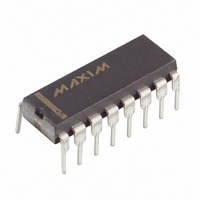MAX712CPE Maxim Integrated Products, MAX712CPE Datasheet - Page 6

MAX712CPE
Manufacturer Part Number
MAX712CPE
Description
IC BATT FASTCHRG NICD/NIMH 16DIP
Manufacturer
Maxim Integrated Products
Datasheet
1.MAX713ESET.pdf
(17 pages)
Specifications of MAX712CPE
Function
Charge Management
Battery Type
Nickel Cadmium (NiCd), Nickel Metal-Hydride (NiMH)
Voltage - Supply
4.5 V ~ 5.5 V
Operating Temperature
0°C ~ 70°C
Mounting Type
Through Hole
Package / Case
16-DIP (0.300", 7.62mm)
Lead Free Status / RoHS Status
Contains lead / RoHS non-compliant
Available stocks
Company
Part Number
Manufacturer
Quantity
Price
Company:
Part Number:
MAX712CPE
Manufacturer:
MAXIM
Quantity:
5 510
Company:
Part Number:
MAX712CPE
Manufacturer:
NS
Quantity:
5 510
Part Number:
MAX712CPE
Manufacturer:
MAXIM/美信
Quantity:
20 000
The MAX712/MAX713 are simple to use. A complete
linear-mode fast-charge circuit can be designed in a
few easy steps. A linear-mode design uses the fewest
components and supplies a load while charging.
1) Follow the battery manufacturer’s recommendations
2) Decide on a charge rate (Tables 3 and 5). The slow-
Depending on the battery, charging efficiency can be
as low as 80%, so a C/3 fast charge could take 3 hours
and 45 minutes. This reflects the efficiency with which
electrical energy is converted to chemical energy within
the battery, and is not the same as the power-
conversion efficiency of the MAX712/MAX713.
3) Decide on the number of cells to be charged (Table 2).
NiCd/NiMH Battery
Fast-Charge Controllers
6
Table 1. Fast-Charge Termination Methods
2C to C/2
Charge
If your battery stack exceeds 11 cells, see the Linear-
Mode High Series Cell Count section. Whenever
changing the number of cells to be charged, PGM0
on maximum charge currents and charge-termination
methods for the specific batteries in your application.
Table 1 provides general guidelines.
est fast-charge rate for the MAX712/MAX713 is C/4,
because the maximum fast-charge timeout period is
264 minutes. A C/3 rate charges the battery in about
three hours. The current in mA required to charge at
this rate is calculated as follows:
< C/2
Rate
> 2C
_______________________________________________________________________________________
I
FAST
ΔV/Δt and
temperature,
MAX712 or MAX713
ΔV/Δt and/or
temperature,
MAX712 or MAX713
ΔV/Δt and/or
temperature, MAX712
= (capacity of battery in mAh)
NiMH Batteries
–––––––––––––––––––––––––
(charge time in hours)
Getting Started
ΔV/Δt and/or
temperature, MAX713
ΔV/Δt and/or
temperature, MAX713
ΔV/Δt and/or
temperature, MAX713
NiCd Batteries
4) Choose an external DC power source (e.g., wall
5) For linear-mode designs, calculate the worst-case
6) Limit current into V+ to between 5mA and 20mA. For a
7) Choose R
8) Consult Tables 2 and 3 to set pin-straps before
and PGM1 must be adjusted accordingly. Attempting
to charge more or fewer cells than the number pro-
grammed can disable the voltage-slope fast-charge
termination circuitry. The internal ADC’s input volt-
age range is limited to between 1.4V and 1.9V (see
the Electrical Characteristics), and is equal to the
voltage across the battery divided by the number of
cells programmed (using PGM0 and PGM1, as in
Table 2). When the ADC’s input voltage falls out of
its specified range, the voltage-slope termination cir-
cuitry can be disabled.
cube). Its minimum output voltage (including ripple)
must be greater than 6V and at least 1.5V higher
than the maximum battery voltage while charging.
This specification is critical because normal fast-
charge termination is ensured only if this require-
ment
MAX712/MAX713 section for more details).
power dissipation of the power PNP and diode (Q1
and D1 in the Typical Operating Circuit) in watts,
using the following formula:
PD
load - minimum battery voltage) x (charge current
in amps)
fixed or narrow-range input voltage, choose R1 in the
Typical Operation Circuit using the following formula:
applying power. For example, to fast charge at a
rate of C/2, set the timeout to between 1.5x or 2x the
charge period, three or four hours, respectively.
R1 = (minimum wall-cube voltage - 5V)/5mA
PNP
is
= (maximum wall-cube voltage under
SENSE
RSENSE = 0.25V/(I
maintained
using the following formula:
(see
FAST
)
Powering
the












